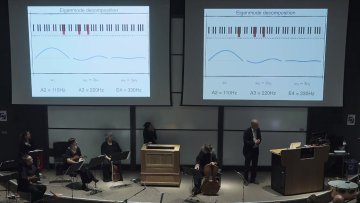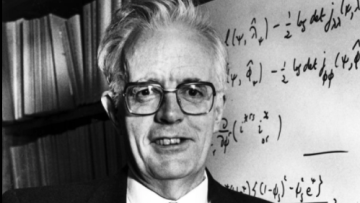12:00
Classical physics and scattering amplitudes on curved backgrounds
Abstract
A particle physics approach to describing black hole interactions is opening new avenues for understanding gravitational-wave observations. We will start by reviewing this paradigm change, showing how to compute observables in general relativity from amplitudes on flat spacetime. We will then present a generalization of this framework for amplitudes on curved backgrounds. Evaluating the required one-to-one amplitudes already shows remarkable structures. We will discuss them in detail, including eikonal behaviours and unexpected KLT-like factorization properties for amplitudes on stationary backgrounds. We will then conclude by discussing applications of these amplitudes to strong field observables such as the impulse on a curved background and memory effects
Deriving the Deligne-Langlands correspondence
Abstract
Affine Hecke algebras and their representations play an important role in the representation theory of p-adic groups since they classify smooth representations generated by Iwahori-fixed vectors. The Deligne-Langlands correspondence, which was proved by Kazhdan and Lusztig, parametrises these representations by geometric data on the Langlands dual group. This talk is supposed to be a gentle introduction to this topic. I will also briefly talk about how this correspondence can be lifted to the derived level.
The Bruhat-Tits building of a p-adic group
Abstract
The Bruhat-Tits building is a mysterious combinatorial gadget that encodes key information about the structure and representation theory of a p-adic group. In this talk we will talk about apartments, buildings, and all the furnishings therein to hopefully demystify this beautiful subject.
Computing magnetohydrodynamic equilibria without symmetries
Abstract
MHD equilibrium is an important topic for fusion (and other MHD applications). A tokamak, in principle, is a toroidally symmetric fusion device and so MHD equilibrium can be reduced to solving the time independent MHD equations in axisymmetry. This produces the Grad-Shafranov equation (a two dimensional, nonlinear PDE) which has been solved using various techniques in the fusion community including finite difference, finite elements and spectral methods. A similar PDE exists if there is a plasma column with helical symmetry. Non-axisymmetric plasmas do occur in tokamaks as a result of instabilities and applied fields. However, if there is no symmetry angle there is no PDE to be solved. The current workhorse for finding non-axisymmetric equilibria uses energy minimization to find the equilibrium. New approaches to this problem that can use state of the art techniques are desirable. The speaker has formulated a coupled set of PDEs for the non-axisymmetric MHD equilibrium problem assuming that flux surfaces are nested (i.e. there are no magnetic islands) and has written this in weak form to use finite element method to solve the equations. The questions are around whether there is an optimal way to try to formulate the problem for FEM and to couple the equations, what sort of elements to use, if other solution techniques would be better suited and so on.
14:00
Recoloring version of Hadwiger's conjecture
Abstract
Las Vergnas and Meyniel conjectured in 1981 that all the $t$-colorings of a $K_t$-minor free graph are Kempe equivalent. This conjecture can be seen as a reconfiguration counterpoint to Hadwiger's conjecture, although it neither implies it or is implied by it. We prove that for all positive $\epsilon$, for all large enough $t$, there exists a graph with no $K_{(2/3 + \epsilon)t}$ minor whose $t$-colorings are not all Kempe equivalent, thereby strongly disproving this conjecture, along with two other conjectures of the same paper.
Signed barcodes for multiparameter persistence
Abstract
Moving from persistent homology in one parameter to multiparameter persistence comes at a significant increase in complexity. In particular, the notion of a barcode does not generalize straightforwardly. However, in this talk, I will show how it is possible to assign a unique barcode to a multiparameter persistence module if one is willing to take Z-linear combinations of intervals. The theoretical discussion will be complemented by numerical experiments. This is joint work with Steffen Oppermann and Steve Oudot.




